Fashion and Lifestyle
What Is a Sickled Foot? Dance Terminology Explained!
Navigate the world of dance with a deeper understanding of how a sickled foot can impact your performance and how to prevent it.
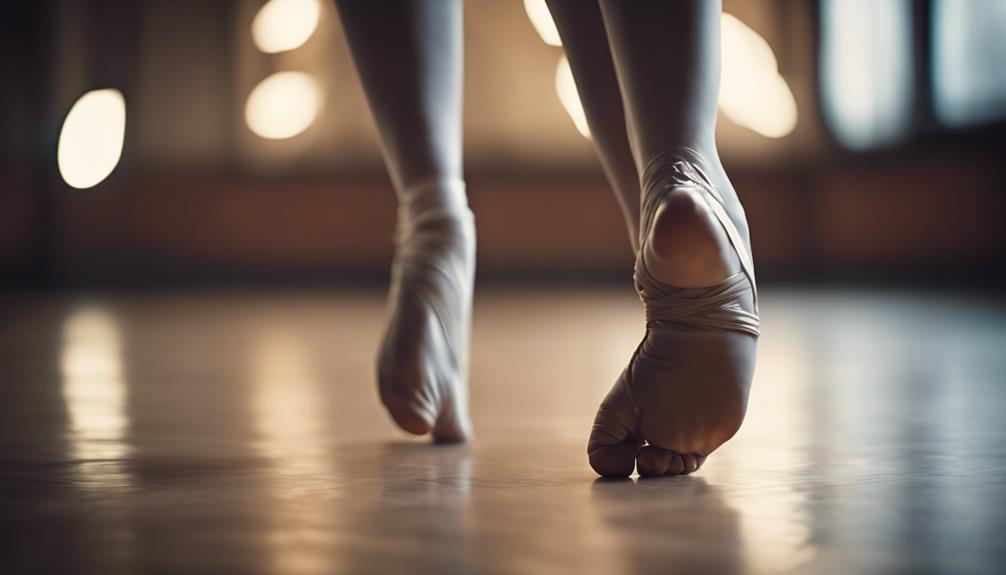
If you're new to dance, a sickled foot is when your foot curves in instead of pointing down naturally. This misalignment can lead to ankle instability and injuries during movements. Strengthening your feet, ankles, legs, and glutes is important to correct this. Focusing on hip strength and alignment rather than the ankles can help prevent sickling. Seeking guidance from professionals and practicing self-awareness exercises can make a significant difference in improving foot alignment. Understanding and addressing this terminology is essential for your dance journey!
Key Takeaways
- Sickled foot in dance is when the foot is pointed too far down or too far out.
- It disrupts proper alignment, stability, and can lead to ankle injuries.
- Incorrect ankle positioning affects movement quality and overall performance.
- Strengthening exercises and proper technique can help prevent sickled feet.
- Professional guidance from podiatrists or physical therapists is essential for correction and prevention.
Causes of Sickled Feet
Sickled feet in dancers result from biomechanical imbalances and muscle weaknesses that affect foot alignment and stability. When the ankle joint isn't properly aligned, it can lead to sickling, where the foot curves inward instead of pointing straight. Avoiding sickled feet is pivotal as it destabilizes ankles, increasing the risk of slips, twists, and sprains during dance movements.
This inward curvature of the toes and dropping back of the heel can also make dancers more prone to tendinitis. Sickling commonly occurs during relevé, glides, jumps, and various dance positions. Factors such as poor form and lack of hip strength can contribute to the development of sickled feet.
Correcting sickled feet is fundamental for preventing injuries and maintaining proper foot alignment in dancers. By addressing these biomechanical imbalances and muscle weaknesses, dancers can improve their foot alignment and overall stability while performing various dance movements.
Podiatrists' Treatment Approach
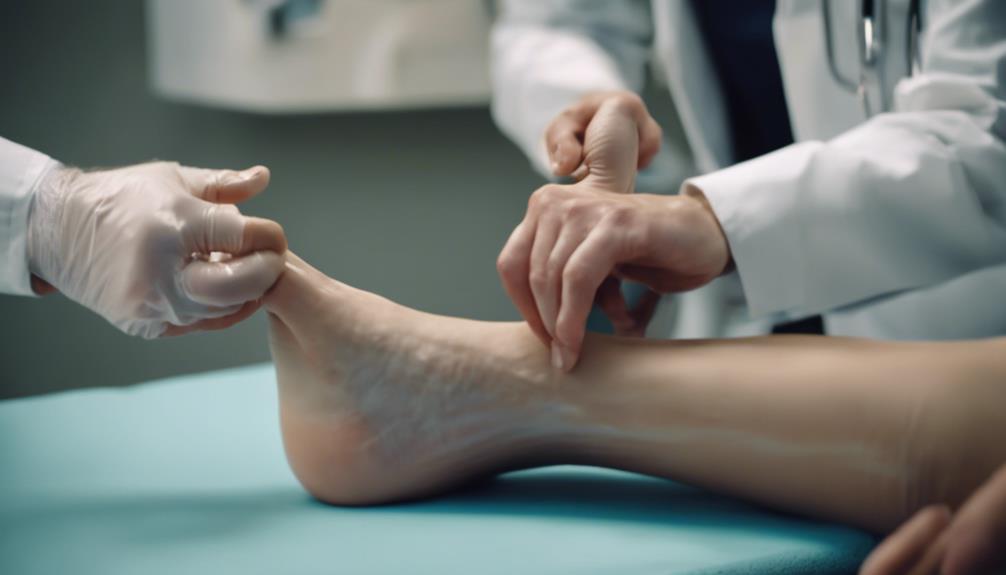
When addressing sickled feet in dancers, podiatrists employ a treatment approach focused on physical rehabilitation and strength building. Podiatrists emphasize the importance of strengthening the feet, ankles, legs, and glutes to correct the issue of sickling.
They recommend targeted strength training exercises to improve the overall stability and alignment of the ankle, which is vital in treating sickled feet. Additionally, podiatrists stress the significance of core strength and endurance training to help prevent injuries associated with this condition.
In some cases, in-house physical rehabilitation specialists may be involved to assist in correcting issues like supination in dancers with sickled feet.
It's essential to address sickled feet promptly as it can help prevent complications such as weakening of the ankle tendons.
At-Home Interventions for Dancers
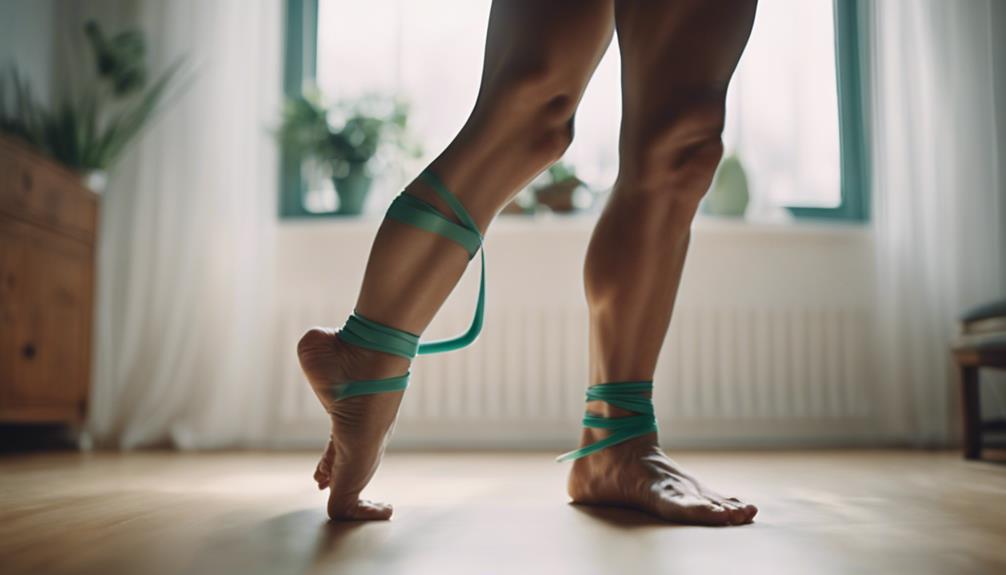
To improve your foot alignment, try a self-awareness exercise to correct supination. Close your eyes and point your toes to check your alignment and increase awareness.
Remember to focus on turning out from your hips, not your ankles, to prevent sickled feet.
Identify Correct Foot Alignment
Start by performing self-awareness exercises to identify and correct any supination in your feet. Check your foot alignment by pointing your toes with your eyes closed to make sure they are properly positioned. When practicing, focus on turning out from the hips rather than the ankles to avoid sickling. By paying attention to these key points, you can prevent potential injuries and strengthen your ankle tendons.
To further aid you in identifying correct foot alignment, use the table below as a reference guide:
| Self-Awareness Exercises | Proper Foot Alignment Tips | Potential Consequences of Incorrect Alignment |
|---|---|---|
| Point toes with eyes closed | Turn out from hips, not ankles | Weakening of ankle tendons |
| Check alignment in the mirror | Engage core for stability | Increased risk of injuries |
| Practice slow tendu exercises | Distribute weight evenly on feet | Decreased balance and control |
| Stretch calf muscles regularly | Wear supportive footwear | Limited range of motion |
Focus on Turnout
Improving turnout at home as a dancer involves focusing on specific exercises to enhance hip strength and flexibility. Proper alignment is essential to avoid sickling, which can strain the ankles and cause instability.
To develop a strong turnout, you can start with simple exercises like clamshells, side-lying leg lifts, and hip rotations. These movements target the hip muscles, aiding in better turnout control and stability.
When working on turnout, remember to engage your core muscles to support your back and pelvis, maintaining proper alignment throughout the exercises. As you progress, incorporating resistance bands or ankle weights can provide added challenge and further enhance hip strength.
Additionally, stretching exercises like seated straddle stretches and frog stretches can help improve flexibility in the hips, allowing for a more extensive range of motion during turnout movements.
Seek Professional Guidance
Seeking professional guidance is essential for dancers looking to address and correct issues related to sickled feet effectively at home. When dealing with sickled feet, turning to expert advice can make a significant difference in your progress.
Here are some key reasons why seeking professional guidance is important:
- Personalized Interventions: Professionals can provide tailored interventions that specifically address your individual needs and challenges.
- Specialized Recommendations: Podiatrists, for example, can recommend precise exercises and techniques to target and correct sickling problems.
- Prevent Complications: Working with a professional can't only help you improve but also prevent further complications by ensuring proper foot alignment.
Preventing Sickled Feet in Ballet

To prevent sickled feet in ballet, focus on correcting your foot alignment and strengthening your hip muscles. These two aspects are essential in maintaining proper form and avoiding the risk of sickling.
Your teachers will stress the importance of these points to help you dance with correct foot positioning.
Correcting Foot Alignment
Ensuring proper foot alignment in ballet involves aligning your toes in a straight line from the calf muscle to prevent sickling.
To correct foot alignment and prevent sickled feet, focus on the following:
- Muscle Memory: Training consistently reinforces the correct alignment, helping your body remember to keep the toes pointed and aligned with the ankle bone.
- Ankle Bone Alignment: Positioning the big toe in line with the ankle bone is pivotal to avoid sickling and maintain a clean line in your footwork.
- Strengthening Exercises: Building strength, flexibility, and balance in your feet and ankles through targeted exercises enhances your ability to maintain proper foot alignment during various ballet movements.
Importance of Hip Strength
Strong hip muscles play a crucial role in maintaining proper turnout and foot alignment to prevent sickled feet in ballet. Hip strength is essential for supporting the body's weight and ensuring stability during dance movements.
When hip muscles are weak, compensatory movements in the feet can occur, increasing the likelihood of sickling. By developing adequate hip strength, dancers can have better control over the positioning of their legs and feet, thereby reducing the risk of sickled feet.
Engaging in targeted exercises to strengthen the hips not only enhances overall dance performance but also helps prevent injuries associated with sickling. Remember, strong hips lead to better turnout and foot alignment, allowing you to dance with precision and grace while minimizing the risk of developing sickled feet through compensatory movements.
Prioritize hip strength training to elevate your ballet technique and protect your feet from improper alignment.
Importance of Protecting Dancers' Feet
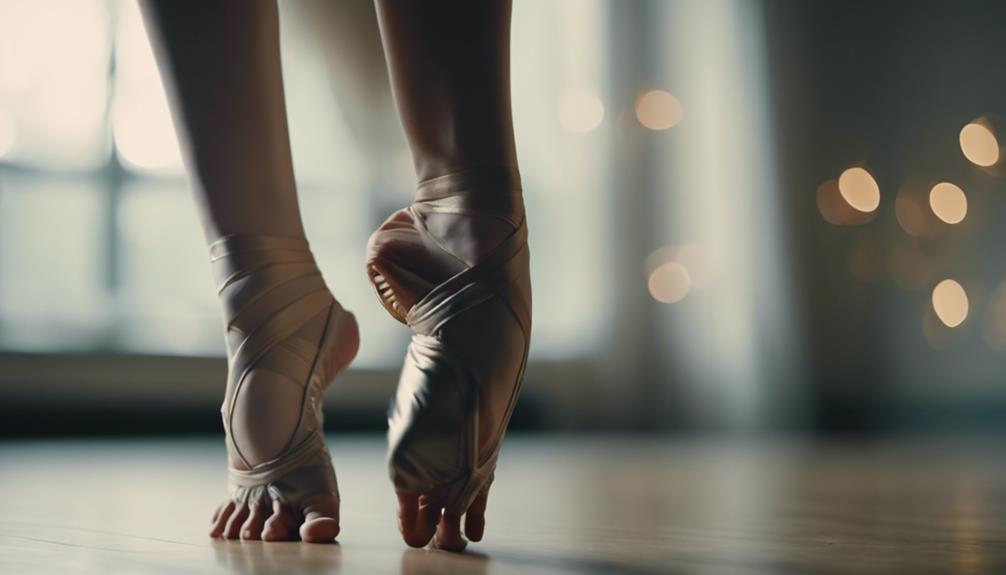
Protecting dancers' feet is vital to safeguard their well-being and longevity in the dance industry. When dancers sickle their feet, it not only affects their performance but also puts them at a higher risk of injuries that can hinder their career progression.
To guarantee dancers' feet are properly cared for, seeking the expertise of a physical therapist is essential. Here are some important points to keep in mind:
- Timely Intervention: Seeking help promptly can prevent further complications and ensure a dancer's overall well-being.
- Specialized Treatments: Tendinitis treatments and in-house x-rays are available to address foot issues related to sickled feet effectively.
- Rehabilitation Options: Athletic physical rehabilitation and MLS laser treatments can aid in the recovery process, helping dancers return to performing swiftly.
Understanding Sickling in Ballet

What's the significance of understanding sickling in ballet?
Sickling, which involves inwardly turning the foot during dance movements, is an essential concept for ballet dancers to grasp. Not only does sickling impact the visual appeal of a performance, but it can also result in instability, affecting a dancer's technique and overall form.
Proper pointe shoe selection plays a critical role in preventing and correcting sickling among ballet dancers. By choosing the right pointe shoes, dancers can maintain proper alignment and avoid the pitfalls associated with sickling.
In classical ballet, sickling is strongly discouraged due to its detrimental effects on form and technique.
To effectively address sickling in ballet, differentiating between pointing and pronating is vital. Understanding the nuances of these movements is key to recognizing and correcting issues related to sickled feet in ballet dancers.
Addressing Foot Issues Related to Sickling
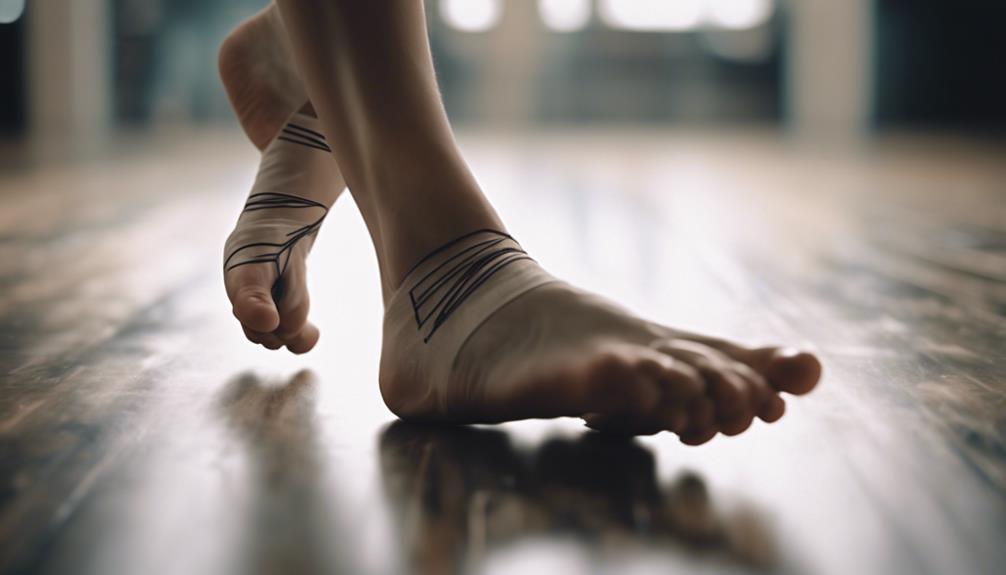
To address foot issues related to sickling in ballet, consider the impact of compressible feet, knuckling, and bunions on dancers' foot health.
Properly fitted pointe shoes can alleviate foot issues related to sickling, providing support and comfort.
Educating yourself on managing foot conditions from sickling can help prevent long-term damage.
Consider Grishko pointe shoe models for customized fitting solutions to address foot issues.
When dealing with foot health concerns stemming from sickling, it's essential to prioritize the proper care and support of your feet. Investing in well-fitted pointe shoes is vital to mitigating the effects of sickling and ensuring best foot health.
By staying informed and seeking professional advice for personalized fitting recommendations, you can actively work towards enhancing both your comfort and performance as a dancer.
Frequently Asked Questions
What Do Sickled Feet Mean in Dancing?
In dancing, sickled feet mean incorrect foot positioning with toes pointing inward and heels dropping back. This can lead to weak ankles and increased injury risk. Proper alignment is essential for stability and injury prevention in dance.
What Is the Difference Between Sickled and Non Sickled Feet?
When you dance, imagine sickled feet like a banana bend, risking ankle woes and strain. Non-sickled? Picture a straight line, no fuss. Strong ankles, less pain. Train right; avoid those sickled feet, and dance on!
What Causes Sickled Feet?
Weak hip muscles, poor form, and genetics can cause sickled feet in dancers. Sickling inwardly curves toes and drops heels, destabilizing ankles and leading to slips and sprains. Avoid this to improve performance and prevent injuries.
What Is the Difference Between Winged and Sickled Foot?
To distinguish between a winged and a sickled foot in dance, remember this: one collapses like a sad balloon arch, the other points inward like a shy turtle's head. Each has its risks.
Conclusion
So there you have it – sickled feet are the bane of every dancer's existence!
Remember, if you want to avoid the dreaded sickling, listen to your podiatrist, do those at-home interventions, and always watch those feet in ballet class.
Your dancing career depends on it! Stay on your toes, literally, and keep those feet happy and healthy.
Dance on, my friends!
Fashion and Lifestyle
Nail Art 101: What Is a Gel Overlay and Why You Need It
Finding the perfect nail enhancement technique can be a game-changer for your nail health and style, but what makes gel overlays a standout option?

You're probably curious about gel overlays, a popular nail enhancement technique. In essence, a gel overlay involves applying a thin layer of hard builder gel onto your natural nails, providing protection, enhancement, and prevention of breakage and peeling. This odorless, healthier alternative to acrylics promotes nail health and longevity, offering a natural look and feel. With minimal filing and curing process, gel overlays excel in application, durability, and appearance. As you explore the world of gel overlays, you'll discover the benefits and possibilities, from design options to maintenance and care, and learn how to achieve the nail look you desire.
Key Takeaways
- A gel overlay is a thin layer of hard builder gel applied onto natural nails for protection, enhancement, and a natural look.
- Gel overlays are odorless, promote nail health, and offer versatility in colors and finishes, making them a healthier alternative to acrylic overlays.
- Preparation involves removing old polish, pushing back cuticles, cleansing, and shaping nails, while maintenance requires regular appointments and necessary repairs.
- Gel overlays provide a long-lasting finish, are lightweight, and prevent breakage and peeling, making them ideal for nail art and design.
- With proper application and care, gel overlays can promote healthy nail growth and longevity, making them a must-have for nail care enthusiasts.
What Is a Gel Overlay?
When you opt for a gel overlay, you're essentially applying a thin layer of hard builder gel directly onto your natural nails, without adding any length or tips. This means that your natural nail shape and size remain intact, while still benefiting from the protection and enhancement that gel overlays provide.
Essentially, a gel overlay is a way to strengthen and beautify your natural nails without altering their natural shape or length. By applying a thin layer of hard builder gel, you're creating a shield that protects your natural nails from breakage and peeling, while also giving them a glossy and natural finish.
This process is lightweight, providing a more natural look and feel compared to other nail extension methods. With a gel overlay, you can rest assured that your natural nails are well-protected and looking their best.
Benefits of Gel Overlays

By choosing a gel overlay, you're not only strengthening your natural nails but also opening yourself up to a multitude of benefits that enhance their overall health and appearance. For starters, gel overlays offer an odourless application process, making them a preferred choice for those sensitive to strong chemical smells. Additionally, they're healthier for your natural nails compared to acrylic overlays, as they require less filing, reducing the risk of damage.
With gel overlays, you can enjoy versatile colours and finishes, allowing for a wide range of customization options to suit your individual preferences. The result is a glossy and natural finish that provides a polished look while enhancing the strength and durability of your natural nails. Plus, less filing of your natural nails is required for gel overlays, making them a gentler option that promotes nail health and longevity.
How Gel Overlays Differ

When delving into the realm of nail enhancements, it's crucial to grasp how gel overlays differentiate from other options. Gel overlays distinctly excel compared to acrylics in application, durability, and overall appearance.
Now, let's dissect the main distinctions that distinguish gel overlays, beginning with their enduring finish.
Gel Vs Acrylic
What sets gel overlays apart from acrylics, and why are they the preferred choice for a more natural look and feel?
For starters, gel overlays use hard builder gel, which adds an extra layer of protection and durability to your nails. This is in contrast to acrylics, which can be harsh on your nails due to the stronger chemicals used. As a result, gel overlays are a gentler option for those with sensitive nails.
While they may be more expensive than acrylic overlays, the benefits are well worth the extra cost. When you opt for a gel overlay, you can expect a more natural appearance and a longer-lasting finish, thanks to the curing process under a UV lamp. This process establishes a strong bond between the gel and your nail, making it less prone to chipping or cracking.
Lasting Finish
You'll notice that gel overlays provide a lasting finish, which sets them apart from other nail enhancement options and makes them a popular choice for those seeking a durable, high-gloss look. This finish is a result of the unique application process, which requires minimal filing of your natural nails, making it a gentler option.
Unlike acrylic overlays, gel overlays don't have a strong odor, making the application process more pleasant. With a wide range of colors and finishes available, you can customize your look to fit your style. The lasting finish of gel overlays is also due to their ability to promote healthier nail growth and maintenance. They're a great option for those who want a long-lasting, high-gloss finish without compromising the health of their natural nails.
With proper care, your gel overlay can last for weeks, making it a convenient and low-maintenance option. Overall, the lasting finish of gel overlays makes them a popular choice for those seeking a durable, high-gloss look.
Preparing for a Gel Overlay

Before applying a gel overlay, remove old nail polish and push back your cuticles to guarantee a clean slate for the application process. This establishes a strong bond between your natural nails and the gel overlay, allowing for a long-lasting finish.
To achieve the best results, it's crucial to prepare your nails properly. Here are some key steps to follow:
- Cleanse your nails: Remove oils and lotions to prevent interference with the gel overlay's adhesion.
- Shape your nails: Gently file your nails to your desired shape, taking care not to file too much, as this can weaken your natural nails.
- Push back cuticles: Gently push back your cuticles to prevent them from getting in the way of the gel overlay application.
- Dry your nails: Ensure your nails are completely dry before applying the gel overlay to prevent moisture from affecting the bonding process.
The Gel Overlay Process
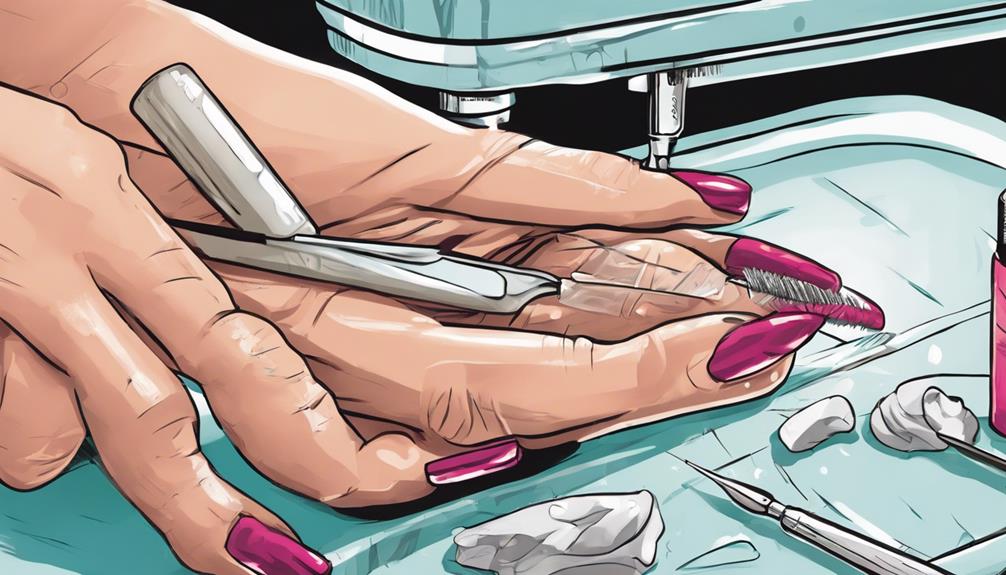
Now that you're ready to start the gel overlay process, it's time to focus on the key steps that'll give you the desired results.
You'll begin by prepping your natural nail, ensuring a clean slate for the gel application.
Next, you'll apply the gel overlay, followed by the finishing touches that'll leave your nails looking salon-fresh.
Prep the Nail
As you begin the gel overlay process, gently buff the surface of your natural nail to remove shine and create a rough texture, allowing the gel to adhere securely. This vital step sets the foundation for a long-lasting and durable gel overlay. By roughening the surface of your natural nail, you're establishing a strong bond between the nail and the gel, guaranteeing a longer wear.
Here are the essential steps to prep your nail:
- Gently buff the surface of your natural nail to remove shine and create a rough texture.
- Apply a bonder or primer to the natural nail to ensure the gel overlay adheres securely and lasts longer.
- Apply a base coat of gel to the natural nail before curing it under a UV or LED lamp to create a strong foundation for the overlay.
- Ensure the nail is clean and dry, free of any oils or lotions, to establish a strong bond between the nail and the gel.
Apply Gel Overlay
With your natural nail properly prepped, you're ready to apply the gel overlay, a process that involves building up thin layers of hard builder gel to add strength and protection. This step is vital in creating overlay nails that offer a natural look and feel.
To begin, apply a thin layer of clear base coat to your prepared nail, making sure to cover the entire surface. Next, use a UV lamp to cure the layer for the recommended time. This step is necessary in creating a strong bond between the gel and your nail.
Continue building up thin layers of hard builder gel, curing each layer with the UV lamp, until you achieve the desired thickness. Remember to finish with a thin layer of top coat to seal and protect your gel overlay.
Finishing Touches
You're in the final stretch of the gel overlay process, where a few finishing touches will transform your nails into stunning, long-lasting masterpieces. The final steps involve shaping and refining the gel overlay to perfection. This is where the magic happens, and your nails are transformed into a work of art.
Here are the essential finishing touches to complete your gel overlay:
- Shaping and refining: Use a nail file to gently shape and refine the gel overlay, ensuring a smooth, even finish.
- Top coat application: Apply a glossy top coat to seal and protect the gel overlay, adding an extra layer of shine and durability.
- Finishing touches: Use a lint-free wipe to gently remove any excess gel or oils from around the cuticles and nail bed.
- Final inspection: Inspect your nails under a Deluxe Laser lamp to detect any imperfections or areas that require touch-ups.
Caring for Your Gel Overlay

Properly caring for your gel overlay requires regular touch-ups to prevent damage and guarantee a long-lasting, salon-fresh finish. You'll need to schedule appointments with your nail technician every two to three weeks to maintain the health and longevity of your overlays.
During these appointments, your technician will assess the condition of your nails and perform any necessary repairs or replacements. This regular maintenance is essential to prevent chipping, cracking, or lifting of the gel overlay.
By keeping up with these appointments, you'll be able to enjoy the benefits of gel overlays, including their lightweight and durable nature, which provides added protection to prevent breakage, splitting, or peeling. Remember, gel overlays are a long-term investment, and with proper care, they can last for several months.
Gel Overlay Vs Gel Extensions

When contemplating your nail enhancement options, it's crucial to understand the differences between gel overlays and gel extensions.
You might be wondering, which one is right for you? Let's break down the key differences between these two popular nail treatments, so you can make an informed decision that suits your nail needs.
Key Differences
When it comes to nail enhancements, sorting out the differences between gel overlays and gel extensions is essential, since they cater to distinct needs and preferences. You may be wondering, what sets them apart?
Here are the key differences to take into account:
- Length: Gel extensions add length to your natural nails, while gel overlays maintain your natural nail length.
- Purpose: Gel overlays provide added strength and protection to your natural nails, whereas gel extensions offer durability and flexibility with added length.
- Maintenance: Gel overlays require less maintenance than gel extensions, making them a convenient option for those seeking enhanced natural nails.
- Commitment: Gel overlays are ideal for individuals looking to reinforce their natural nails without the commitment of extensions.
Lasting Results
You can expect a noticeable difference in longevity between gel overlays and gel extensions, with the former typically lasting 2-3 weeks on natural nails and the latter persisting for 3-4 weeks with proper care. This difference in duration is important in deciding which option suits you best.
| Type | Duration | Purpose |
|---|---|---|
| Gel Overlay | 2-3 weeks | Strengthen natural nails |
| Gel Extensions | 3-4 weeks | Add length and durability |
| Gel Overlay | 2-3 weeks | Ideal for nail strengthening |
| Gel Extensions | 3-4 weeks | Preferred for added length |
When choosing between a gel overlay and gel extensions, consider your personal preferences, nail health, and desired maintenance routine. If you want to strengthen your natural nails without added length, a gel overlay is the way to go. However, if you're looking for longer nails with added durability, gel extensions are the better choice. By understanding the lasting results of each option, you can make an informed decision that suits your needs.
Design Options and Ideas
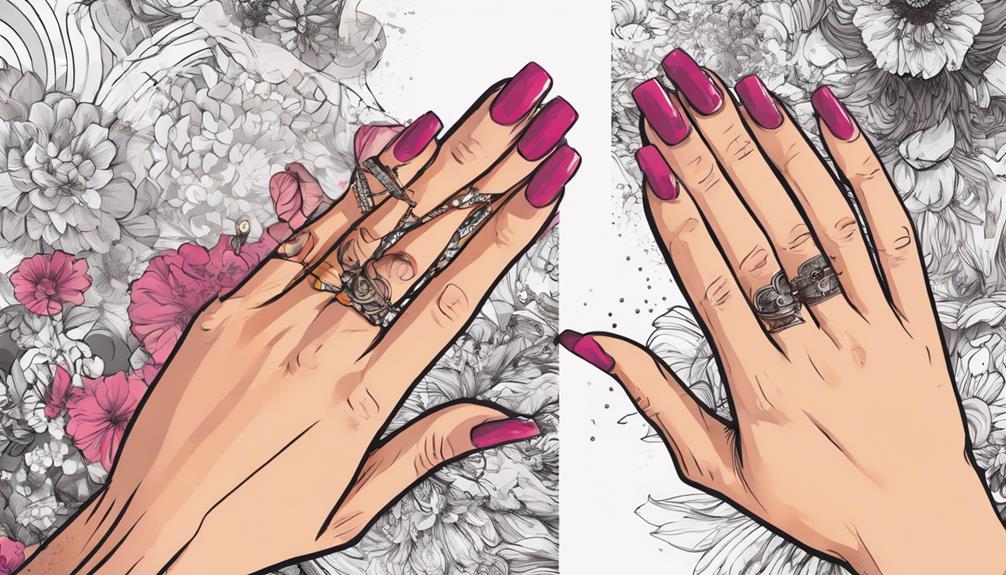
With gel overlays, you can tap into your creativity and explore a vast array of design options that cater to your unique style and preferences. Overlays need not be limited to simple, solid colors – the possibilities are endless!
Here are just a few design options to get you started:
- French tips: Add a touch of elegance with crisp, white tips that complement any outfit.
- Gradient effects: Gradually shift from one color to another for a mesmerizing, multi-tonal look.
- Glitter accents: Add some sparkle and shine with subtle or bold glitter accents that catch the light.
- Intricate nail art designs: Get creative with stamping, marbling, or freehand painting techniques to create one-of-a-kind masterpieces.
With gel overlays, you can customize your nail art with a wide range of colors, textures, and finishes to suit your individual style. From subtle and understated to bold and eye-catching, the design options are truly limitless.
Whether you're looking for a classic, timeless look or a trendy, statement-making design, gel overlays provide the perfect canvas for your creativity.
Common Gel Overlay Mistakes

As you experiment with gel overlays, it's equally important to be mindful of the common mistakes that can compromise the quality and longevity of your nail art.
One common mistake is applying gel overlays on weak, damaged nails, which can lead to lifting and premature chipping.
You should also avoid incorrect curing times or inadequate lamp strength, as this can result in gel overlay peeling or cracking.
Skipping proper nail preparation steps like dehydration and priming can also cause gel overlays to lift.
Additionally, using expired or low-quality gel products can compromise the longevity and quality of your gel overlays.
Lastly, be cautious not to over-file or excessively buff your natural nails before applying gel overlays, as this can weaken the nail structure and lead to breakage.
Maintaining Healthy Nails

Regular gel overlay maintenance appointments become an essential shield against nail damage, ensuring your natural nails stay healthy and strong. With regular appointments, you can prevent common nail problems like breakage, splitting, or peeling. Gel overlays provide a protective layer that safeguards your natural nails from damage, promoting overall nail health.
Here are some benefits of gel overlays for maintaining healthy nails:
- Less filing: Gel overlays require less filing of your natural nails, preserving their integrity.
- Odourless application: The application process is odourless, making it a more comfortable experience for you.
- Gentle chemicals: Gel overlays use milder chemicals compared to acrylic overlays, making them a gentler option for nail enhancement.
- Natural finish: Gel overlays offer a glossy and natural finish, enhancing the appearance of your nails while maintaining their health.
Frequently Asked Questions
What Is the Point of Gel Overlays?
You're wondering what's the point of gel overlays? Well, they provide a protective shield, preventing breakage and promoting healthier nail growth, while also offering customization options and a natural look that's lightweight and long-lasting!
What Does Overlay Do to Your Nails?
You'll be amazed to know that 80% of women experience nail breakage; a gel overlay helps! It strengthens and protects your natural nails, promoting healthy growth, and adds a glossy finish, all while allowing for customization with various colors and finishes.
Which Is Better, Acrylic or Gel Overlay?
You're wondering which overlay is better, acrylic or gel? Honestly, gel overlays are the way to go – they're odorless, gentler on your nails, and offer a natural finish, making them a superior choice for nail health and style.
What Is the Difference Between Hard Gel and Overlay?
You're wondering what sets hard gel apart from overlay – hard gel is used for nail extensions, whereas gel overlay adds a protective layer to your natural nails without extending their length.
Conclusion
As you now know, gel overlays are a game-changer for your nail game. With their long-lasting, high-gloss finish and versatility in design, it's no wonder they're a popular choice.
By following the tips and tricks outlined above, you'll be well on your way to achieving salon-quality nails from the comfort of your own home. With a little practice and patience, your nails will be the envy of all your friends, shining bright like a beacon of nail art excellence.
Fashion and Lifestyle
The Classic Tuxedo: Timeless Elegance for Any Occasion!
Timeless elegance meets modern flair with the classic tuxedo – a must-have for any occasion!

The classic tuxedo radiates timeless grace, suitable for any event! With satin lapels, single buttons, and sleek design, it displays refined style effortlessly. Coordinate with a white dress shirt, black bow tie, and accessories like cufflinks for added flair. Modern trends allow for personalization and experimentation, enhancing the classic look. Tuxedo accessories like cufflinks, studs, and pocket squares add the final touch of sophistication. Ensure proper fit and quality fabric for a polished appearance at formal events. Discover more about the historical significance, anatomy, and styling tips to elevate your tuxedo game!
Key Takeaways
- Originating in the 1860s, the classic tuxedo symbolizes timeless elegance at formal events.
- Lapels with satin, single-button style, and tailored fit define the tuxedo's refined details.
- Coordinating shirt, bow tie, and accessories enhance the tuxedo's sophistication.
- Modern trends include slim-fit silhouettes, bold colors, and personalized touches for a contemporary look.
- Key elements like cufflinks, studs, cummerbunds, and pocket squares elevate the tuxedo ensemble.
Historical Significance and Evolution
The historical journey of the classic tuxedo, from its origins in the 1860s to its prominence at black-tie events, showcases its evolution and enduring appeal. With a rich history steeped in elegance and sophistication, the classic tuxedo has transcended time, symbolizing timeless elegance and refined style.
Originally emerging as formal eveningwear, the tuxedo suit underwent an evolution that led to its widespread recognition and adoption at black-tie events.
The historical significance of the classic tuxedo lies in its ability to exude class and charm, making it a fashion statement that has stood the test of time. Its evolution from a niche attire to a staple in formal events speaks volumes about its cultural impact and enduring relevance.
Understanding the journey of the classic tuxedo reveals not only its sartorial evolution but also its symbolic importance in representing a standard of elegance and sophistication that remains unparalleled.
Anatomy and Details of Tuxedo Suit

Exquisite workmanship and meticulous attention to detail define the anatomy and intricate features of a tuxedo suit. When it comes to the construction of a tuxedo suit, several key elements play an essential role in creating its sophisticated and timeless appeal. Here's a breakdown of the vital components:
| Elements | Description |
|---|---|
| Lapels | The lapels of a tuxedo jacket, often adorned with satin, add a touch of luxury and formality to the ensemble. |
| Buttons | The number and style of buttons on a tuxedo jacket can vary, with single-button closures being a popular choice for a sleek and modern look. |
| Vents | Vents, or lack thereof, on the back of the jacket can influence the fit and style, with ventless designs offering a clean and tailored appearance. |
| Pockets | Thoughtfully placed pockets on a tuxedo jacket provide both functionality and aesthetics, allowing for a seamless look. |
| Tailored Jackets | Tailored jackets are essential for a well-fitted tuxedo suit, emphasizing the wearer's silhouette and ensuring a polished appearance. |
| Satin Stripes | Black trousers with satin stripes are a classic feature of a tuxedo suit, adding a subtle contrast and elegance to the overall look. |
Shirt, Bow Tie, Accessories Coordination

When coordinating your formal accessories, remember to harmonize your shirt and bow tie for a stylish tuxedo look.
Opt for a crisp white dress shirt with French cuffs and a wing collar as your base.
Choosing a black silk or satin bow tie adds elegance and complements the lapel fabric seamlessly.
Coordination of Formal Accessories
To achieve a polished and stylish look with your tuxedo suit, focus on coordinating your formal accessories such as the shirt, bow tie, and other accompanying details. Opt for a crisp white dress shirt with French cuffs to elevate the ensemble, paired with a black silk or satin self-tie bow tie that complements the lapel material.
Adding subtle elegance, carefully selected cufflinks, pocket squares, and stud sets complete the formal look. Additionally, consider incorporating accessories like cummerbunds, waistcoats, and dress watches to add sophistication and a touch of personal style to your tuxedo attire.
Harmonizing Shirt and Bow Tie
Proper coordination of the shirt, bow tie, and accompanying accessories is essential for achieving a sophisticated and cohesive tuxedo ensemble. When selecting a shirt to complement your tuxedo, opt for a classic white formal shirt for timeless elegance. This crisp base allows the bow tie to stand out as a focal point of your outfit.
The bow tie should harmonize with the color scheme of your tuxedo, creating a balanced and polished look. Consider coordinating your cufflinks with your bow tie for a harmonious touch. These small details can make a significant impact on your overall appearance.
Accessories like cufflinks, studs, and pocket squares should enhance your ensemble without overpowering it. Remember, the goal is to achieve a refined and cohesive tuxedo outfit that exudes sophistication. Master the art of coordinating your shirt, bow tie, and accessories to elevate your classic tuxedo suit to the next level of elegance.
Stylish Tuxedo Accessories
Ensure your tuxedo accessories, including the shirt, bow tie, and accompanying details, are seamlessly coordinated to elevate your overall look to the pinnacle of sophistication. When selecting accessories for your tuxedo, focus on elements like cufflinks, studs, and pocket squares to enhance the ensemble's elegance. These small details can make a significant impact on your overall appearance.
Additionally, consider incorporating cummerbunds or waistcoats to add a touch of refinement to your outfit. A well-chosen dress watch can also contribute to the sophistication of your look.
To further enhance your tuxedo ensemble, don't overlook the significance of lapel pins or boutonnieres. These subtle additions can bring a unique flair to your outfit and showcase your attention to detail.
Occasions and Modern Trends
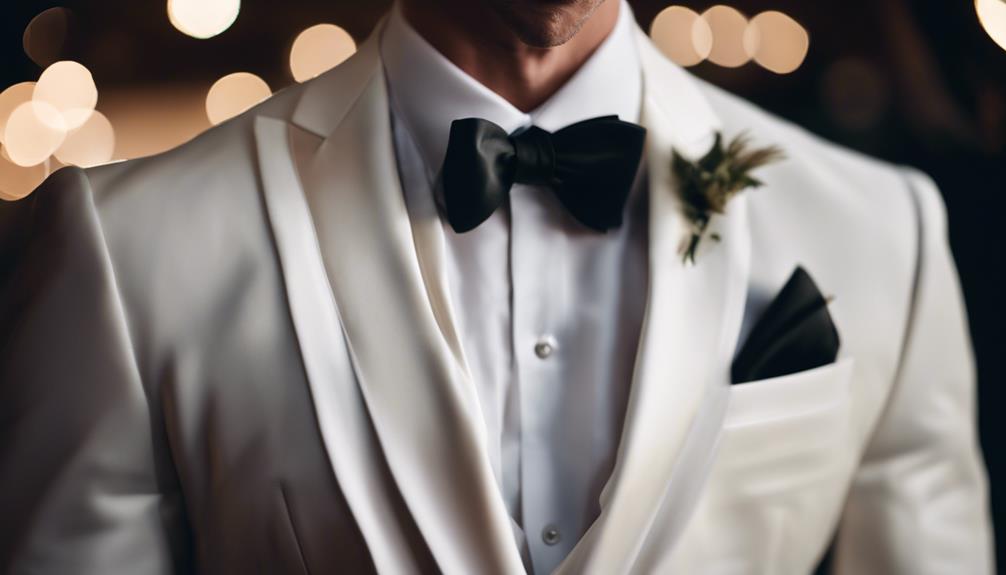
For occasions where style and sophistication are key, contemplate integrating modern trends into your tuxedo attire. When aiming to make a statement at formal events, embrace modern variations while maintaining the timeless appeal of the classic black tuxedo. To achieve a polished look with an air of elegant sophistication, here are some key elements to take into account:
- Slim-fit Silhouettes: Opt for a tuxedo suit with a tailored, slim-fit silhouette to exude modern elegance.
- Bold Colors and Textures: Experiment with colors beyond traditional black and incorporate rich textures like velvet and jacquard for a contemporary twist.
- Personalized Details: Add personalized touches such as monograms or unique buttons to showcase your individual style.
- Shawl Collar Designs: Choose tuxedos with shawl collar designs for a sophisticated and fashion-forward look.
- Tailored Silhouettes: Embrace tailored silhouettes that enhance your body shape and offer a modern take on classic tuxedo styles.
Importance of Tuxedo Accessories

Enhance your tuxedo ensemble with crucial accessories that add sophistication and personal flair to your overall look. Tuxedo accessories like cufflinks, studs, cummerbunds, and pocket squares are essential finishing touches that elevate the classic tuxedo suit. These accessories provide subtle details that play a significant role in completing the timeless elegance of your outfit.
Consider the following table for a quick overview of the key tuxedo accessories:
| Tuxedo Accessories | Description |
|---|---|
| Cufflinks | Add a touch of luxury and style to your shirt cuffs. |
| Studs | Replace buttons on your dress shirt for a polished look. |
| Cummerbunds | Accentuate your waistline and provide a sleek finish to your tuxedo. |
| Pocket Squares | Inject personality and color into your ensemble with a well-folded pocket square. |
Opt for silver or gold accents in these accessories to complement your tuxedo without overshadowing it. Remember, well-coordinated accessories not only add sophistication but also allow for self-expression and style customization.
Foundations of Black Tie

You must grasp the crucial components of black tie attire to embody timeless sophistication. Understanding the dress code essentials and key attire elements is fundamental to mastering the classic tuxedo look.
The jacket, trousers, shirt, bow tie, and accessories all play a pivotal role in creating a polished black tie ensemble.
Dress Code Essentials
Mastering the foundations of black tie attire is crucial for understanding the key components of a classic tuxedo ensemble. When it comes to dress code essentials for formal occasions, the tuxedo suit is your go-to choice for making a fashion statement. Here are the key elements to keep in mind:
- Jacket: The cornerstone of your ensemble, featuring lapels, buttons, and vents that contribute to the overall look.
- Trousers: Tailored to perfection for an ideal fit, complementing the jacket seamlessly.
- Dress Shirt: A crisp white shirt with a wing collar and French cuffs provides a sophisticated backdrop for accessories.
- Bow Tie: Opt for a self-tie bow tie to add refinement and personality to your look.
- Accessories: Complete your ensemble with cufflinks, pocket squares, and stud sets to express personal style elegantly.
Understanding these essentials will guarantee you're impeccably dressed for any black-tie affair.
Key Attire Elements
Understanding the foundational elements of black tie attire is necessary for confidently donning a classic tuxedo ensemble. The classic tuxedo comprises a black jacket, trousers, dress shirt, bow tie, and accessories, all important for formal occasions.
To achieve a polished look and timeless elegance, pay attention to intricate details such as lapels, buttons, vents, and pockets on the jacket and trousers. These elements contribute to the overall sophistication of the ensemble. Additionally, ensuring the proper fit, high-quality fabric, and tailored aspects of each component are essential for a refined appearance.
The classic tuxedo embodies tradition and class, making it a timeless choice suitable for various formal events. By mastering the key attire elements of a classic tuxedo, you can exude confidence and sophistication at any black-tie affair.
The Jacket Details
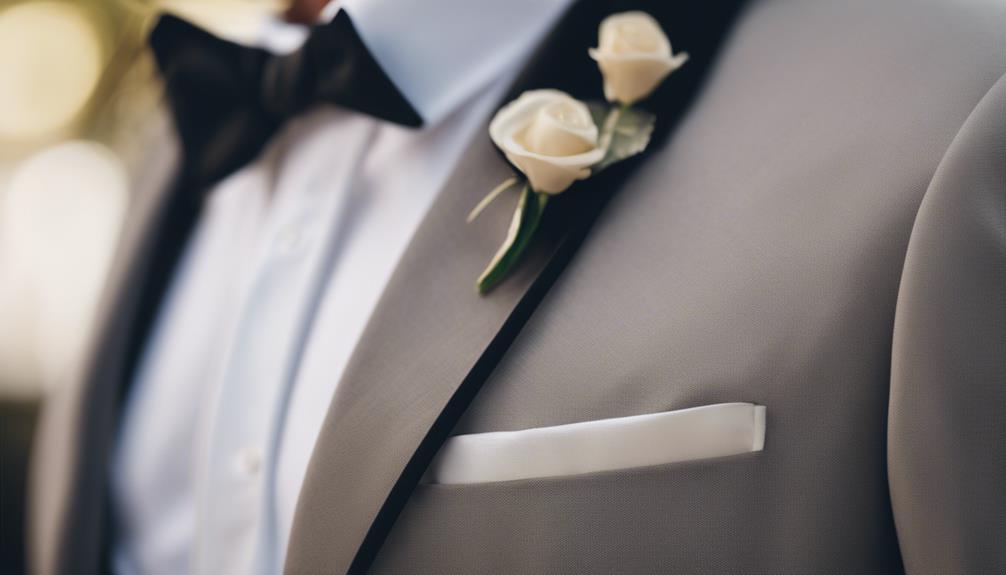
When examining the tuxedo jacket details, the satin or grosgrain lapels stand out as luxurious accents that elevate the overall look. The tuxedo jacket typically comes in black or midnight blue, exuding sophistication and elegance.
Here are some key features to contemplate:
- Satin Lapels: The smooth satin lapels add a touch of elegance to the jacket, catching the light and creating a sophisticated contrast.
- Grosgrain Lapels: For a more textured look, grosgrain lapels provide a subtle yet refined detail to the tuxedo ensemble.
- Single Button Closure: The single button closure offers a sleek and minimalist appearance, perfect for a classic and timeless style.
- Ventless Back Design: With a ventless back design, the jacket maintains a clean and polished aesthetic, enhancing the overall silhouette.
- Refined Appearance: When selecting a tuxedo jacket, focus on the fit, lapel style, and fabric quality to achieve a refined and distinguished look for any formal occasion.
The Trousers and Dress Shirt

Taking center stage in the classic tuxedo ensemble are the sleek trousers and crisp white dress shirt, each playing an essential role in achieving a polished and formal look. The black tuxedo trousers are crafted to be sleek and understated, often featuring satin side stripes that add a touch of elegance. Paired with a crisp white dress shirt, preferably with French cuffs and a wing collar, the ensemble exudes sophistication suitable for formal occasions. The dress shirt may also include pleats or a bib front, providing elegant detailing that complements the tuxedo jacket seamlessly.
To highlight the key elements of tuxedo trousers and dress shirts, refer to the table below:
| Tuxedo Trousers | Crisp White Dress Shirt |
|---|---|
| Sleek design | French cuffs |
| Satin side stripes | Wing collar |
| Made from matching fabric | Pleats or bib front |
Frequently Asked Questions
What Is the Most Classic Tuxedo?
For the most classic tuxedo, opt for black or midnight blue with single-button closure and satin or grosgrain lapels. Guarantee a tailored fit, peak lapels, and black trousers with satin stripes for timeless elegance.
What Tuxedo Does James Bond Wear?
You should wear the iconic 'Dinner Jacket' like James Bond. It's a sleek black tuxedo with a peak lapel, a white shirt, a black bow tie, and satin-striped trousers. This ensemble exudes timeless elegance for any occasion.
What Is the Meaning of Classic Tuxedo?
When you ask about the meaning of a classic tuxedo, it's all about timeless style and sophistication. This formal ensemble, with its tailored jacket, matching trousers, and elegant accessories, exudes refinement and charm at any special occasion.
What Occasion Is Appropriate for a Tuxedo?
For you, a tuxedo is perfect for sophisticated events like black-tie galas and formal weddings. It elevates your style, showing respect for the occasion and adding an air of elegance. Stand out and celebrate in style!
Conclusion
So, next time you're getting dolled up for a swanky event, don't forget to rock that classic tuxedo!
With its timeless elegance and suave vibes, you'll be turning heads and stealing the show.
Just make sure to throw on your spiffy cufflinks and pocket square for that extra touch of class.
Remember, a well-fitted tux never goes out of style, so embrace the dapper charm and let your confidence shine like a disco ball!
Fashion and Lifestyle
What Is Thick Water? The Hydration Solution Explained!
Discover how Thick Water, a hydration solution for swallowing difficulties, offers a safer option for hydration with its unique thickening properties.

Thick water is water with a thickening substance added to aid in swallowing for individuals with conditions like dysphagia. It reduces the risk of choking and aspiration pneumonia, ensuring safer hydration. Made by mixing water with a powder or gel to create a texture that is easier to swallow. The Thick-It Clear Advantage provides specific thickness options for an essential hydration solution. It guarantees a consistent texture and is convenient to use. Discover more about its benefits and impact on body hydration.
Key Takeaways
- Thick water is water thickened with substances like powder or gel for easier swallowing.
- It reduces the risk of choking and aspiration pneumonia, especially for individuals with swallowing difficulties.
- Thick water maintains hydration levels and aids in preventing dehydration in those with dysphagia.
- Different types of thickened water can influence body hydration and thirst sensation.
- Thick-It Clear Advantage offers nectar consistency thickened water for specific thickness needs.
Benefits of Thick Water
Reducing the risk of aspiration pneumonia and choking, thick water offers essential benefits for individuals with swallowing difficulties. Thickened liquids like thick water help prevent choking, especially for those with a neurological condition that affects their ability to swallow effectively.
By providing a consistent thickness, thick water ensures a safer swallowing experience, allowing individuals to drink water without the fear of aspiration.
In addition to reducing the risk of choking, thick water also helps individuals with dysphagia maintain proper hydration levels. This is essential for overall health and well-being, as dehydration can lead to various complications, particularly in individuals with swallowing difficulties.
How Thick Water Is Made

To produce thick water, a thickening substance like powder or gel is added to water, resulting in a pudding-like texture that aids in easier swallowing.
Here's how thick water is prepared:
- Select Your Thickening Substance: Choose between powder or gel-based thickening substances. Powdered choices are convenient and have a longer shelf life, while gel-based options offer a different texture.
- Adjust Texture: The quantity of thickening substance used determines the final texture of the thick water. Adding more thickener creates a denser liquid, while using less results in a slightly thinner texture.
- Blend Thoroughly and Enjoy: After adding the thickening substance to the water, mix it well to make sure it's fully integrated. Then, you're ready to drink your thickened liquid and enjoy the advantages of easier swallowing.
Thick-It Clear Advantage Overview

Thick-It Clear Advantage offers nectar consistency thickened water for individuals who require specific thickness levels for easier consumption. This thickened water is a game-changer for those facing difficulty swallowing liquids.
Clear Advantage, available for purchase at Cart Health, guarantees a consistent texture that aids in preventing dehydration in individuals with dysphagia. By maintaining a steady thickness in the water, it also reduces the risk of choking, providing peace of mind during drinking.
The product's convenient packaging makes it simple to use and store, catering to daily hydration needs effortlessly. For those seeking a reliable solution to make drinking safer and more manageable, Thick-It Clear Advantage stands out as a practical choice.
Say goodbye to struggles with maintaining hydration and hello to a smoother drinking experience with Clear Advantage.
Benefits of Thick Water

Switching gears to the benefits of thick water, users experience improved safety and hydration, making it a valuable choice for individuals with swallowing difficulties.
When opting for thickened liquids, you can:
- Reduce the Risk of Aspiration Pneumonia: Thick water helps to minimize the chances of aspiration pneumonia in individuals with swallowing difficulties, promoting better respiratory health and overall well-being.
- Maintain Proper Hydration Levels: For those facing swallowing challenges, thickened beverages play an essential role in preventing dehydration, ensuring that the body remains adequately hydrated throughout the day.
- Enhance Swallowing Safety: By providing a consistent thickness, thick water lowers the risk of choking during swallowing, allowing individuals with dysphagia to consume fluids more comfortably and securely.
Thick water serves not only as a hydration solution but also as a supportive aid in managing swallowing difficulties, offering a practical and beneficial option for individuals with specific needs.
Thirstiness and Body Hydration Study

In the study examining thirstiness and body hydration, the stability of oral mucosa hydration over 3 hours without drinking was observed. Researchers found that different types of thickened water influenced body hydration and thirst sensation.
While thickened water helped maintain hydration levels, it mightn't alleviate thirst like regular water does. Thirst, dry mouth, and the desire to drink showed significant variations with different stimuli in the study.
Surprisingly, water intake saw an increase after 90 minutes when individuals consumed a starch-based thickener according to the research. These findings highlight the complex relationship between thickened liquids, body hydration, and thirst sensation.
Understanding how these factors interact can provide valuable insights for individuals who rely on thickened water for hydration purposes. Ultimately, the study sheds light on the importance of considering both hydration maintenance and thirst satisfaction when managing hydration with thickened water.
Frequently Asked Questions
Is Thick Water Actually Hydrating?
Yes, thick water can be hydrating, but it might not quench your thirst like regular water. Different thickened water types affect hydration and thirst sensation. If you dislike it, you may need more time to drink it.
Why Do People Drink Thickened Water?
You drink thickened water to manage swallowing difficulties and lower the risk of aspiration pneumonia. It promotes safer swallowing for conditions like stroke or Parkinson's. The pudding-like consistency aids consumption, prevents choking, and helps maintain hydration and nutrition levels.
What Is the Meaning of Thick Water?
Thick water is water thickened with a powder or gel to assist those with swallowing difficulties. It's commonly used for dysphagia, aiding in preventing aspiration pneumonia by ensuring liquids are safely swallowed.
How to You Make Thick Water?
To make thick water, you combine regular water with a thickening agent, adjusting to reach the desired consistency. Take care not to overdo it, as too much thickener can make the water too gloopy to drink easily.
Conclusion
Just like Thick Water provides a solution for those with swallowing difficulties, it also symbolizes the importance of finding alternative ways to overcome challenges.
By adapting and innovating, we can find new ways to stay hydrated and nourished, even in the face of obstacles.
Let Thick Water serve as a reminder that perseverance and creativity can lead to unexpected solutions in our daily lives.
-

 Culinary Delights2 months ago
Culinary Delights2 months agoBanish Roaches: Get Rid of Cockroaches in Kitchen Cabinets
-

 Finance and Technology2 months ago
Finance and Technology2 months agoThreshold Delivery Explained: Quick Guide
-

 Health and Wellness2 months ago
Health and Wellness2 months agoAesthetic Enhancement: What Exactly Is a Banana Roll?
-
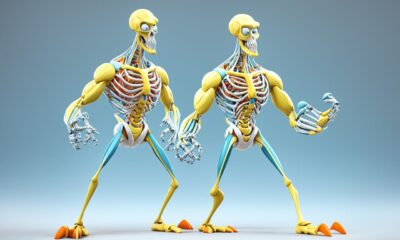
 Finance and Technology2 months ago
Finance and Technology2 months agoUnderstanding What is an Adaptation Apex
-

 Health and Wellness2 months ago
Health and Wellness2 months agoUnderstanding What is an Exchange Surgery
-

 Culinary Delights2 months ago
Culinary Delights2 months agoMonocalcium Phosphate Guide – Uses & Benefits
-

 Sports and Recreation2 months ago
Sports and Recreation2 months agoOn the Green: Understanding the Role of a Forecaddie
-

 Culinary Delights2 months ago
Culinary Delights2 months agoDiscover What is Kippered Beef: A Tasty Treat















